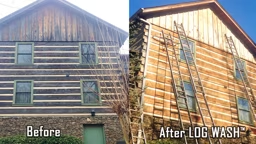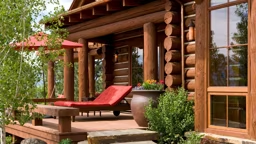
Every log cabin homeowner has had those “what if” thoughts. What if conditions become so dry that a wildfire starts near my cabin? What if the rain is so relentless the lake outside my doorstep begins to overflow its banks? What if tornado-fueled winds threaten to destroy everything I’ve created?
Those extreme scenarios are tough to think about because there’s nothing you can do to prevent them from happening. That’s the bad news. The good news? There are ways you can use your landscaping to minimize the damage that extreme weather can cause and still have an attractive yard all at the same time. Here are a few tips for using your outdoor resources in a way that can lessen a natural disaster’s impact on your log home:
Wildfires:
The key to keeping fires from damaging your home is regular maintenance with a focus on how fires spread — embers are often the culprit. Begin by removing dead plants like trees and shrubs promptly and trimming any branches that overhang the property or have close contact with the log walls. (Remember: Keep all shrubs and bushes at least 3 feet away from your logs to prevent moisture from collecting on the wood, not to mention fire prevention). Never leave piles of brush or leaves near the house because they can ignite easily. It’s also a good idea to install irrigation in a 50-foot radius around your home to help create a fireproofing perimeter.
 If you live on a body of water, place your log home on a pedestal! Sloping the soil downward and away from the house in all directions will greatly reduce the chance of flooding.
If you live on a body of water, place your log home on a pedestal! Sloping the soil downward and away from the house in all directions will greatly reduce the chance of flooding.
Floods:
A massive amount of flooding that leaves your house and yard in standing water is a tall order in terms of prevention strategies, but more moderate flooding can be stopped with a few simple landscaping tricks. The best way to begin is to grade your soil so that it slopes downward and away from your home in all directions. You can create extra drainage through the use of strategically placed stones and bushes that direct water away from the foundation. In spots that tend to gather standing water, install a rain garden with native plants, which can help with water absorption.
Tornadoes:
To minimize the damage caused by the sustained winds and sudden gusts tornado weather brings, be sure to keep trees and shrubs trimmed (which you’ll be doing anyway to prevent fire spread) and consider replacing gravel or rock landscaping with lighter materials like shredded bark. Also, check to ensure any yard ornaments (like birdbaths, pots or statues) are heavy enough to withstand high winds or plan to bring them indoors during a tornado watch.
To learn more about what you can do to keep you and your home safe in the event of a natural disaster, contact your local Department of Natural Resources (DNR). They often have disaster prevention specialists on staff who can take a look at your property and create a personalized strategy to help you be prepared no matter what Mother Nature throws your way.











